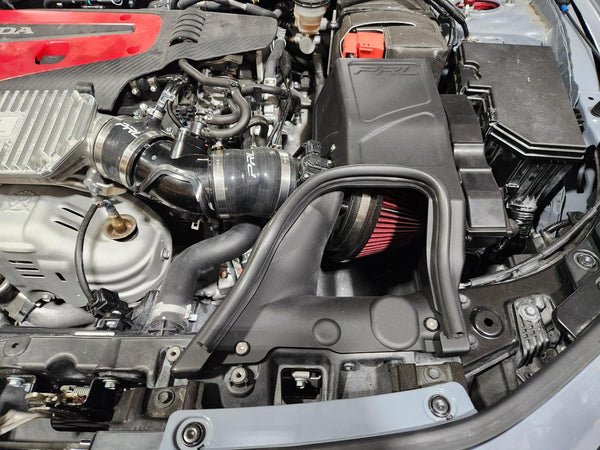In order to continue improving our intercooler designs, we equipped our 2022 Honda Civic 1.5L Turbo Touring model test mule with some additional sensing equipment. We are using one type-j thermocouple and one 50psi MAP sensor at the intercooler inlet, and one of each at the outlet. These are interfaced through an AEM CD-5 Digital dash, where we can monitor and log change in temperature and change in pressure across our intercooler cores. Having access to this data during R&D allows us to fine tune important aspects of our intercoolers such as fin density, fin pitch, core dimensions and end tank design in order to squeeze every ounce of horsepower out of our products. The dyno session was started by taking a completely stock baseline run at an average temperature of 59°F and an elevation of 1160ft. We saw some very interesting trends as far as the performance of the stock intercooler, but more on that later. After our baseline testing, we went ahead and swapped the stock intercooler for our upgraded intercooler and resumed testing. Here’s what we found:

We saw a maximum recorded power of 171WHP and an average of 146WHP with the stock intercooler, and a maximum recorded power of 176WHP and an average of 149WHP with our intercooler. However, we saw as much as a 9WHP increase in the mid-range. After completing the power runs, we went ahead and performed an intercooler performance test on each intercooler. This consisted of doing a pull in the car from 20MPH to 110MPH, allowing a 26-second interval (approximate time of pull plus 15 seconds), then repeating that procedure multiple times until each intercooler reached heat soak. Heat soak was determined when we were no longer seeing a significant increase in the outlet temperature of the intercooler.

During the heat soak test, it can be seen that the intercooler inlet temperatures remained consistent with each other, with slight deviation, however, the outlet temperatures were significantly different. With the stock intercooler, we were seeing temperature spikes as high as 220°F after a few pulls. Furthermore, the peak outlet temperature of the initial pull was 162°F where the PRL intercooler was 78°F. The PRL intercooler reached heat soak at around 112°F compared to the stock 220°F.

Zooming in on one of the runs, we can really see the stark contrast in the performance of both intercoolers. Just to make sure this was not due to changing air temperatures, we logged the ambient air temperature entering the intercooler using another type-j thermocouple hung in front of the core for both runs. It can be seen on the graph, that the ambient air temperature was very consistent between runs.

Having access to this specific temperature data also allowed us to calculate the effectiveness of each intercooler. The effectiveness of a heat exchanger can be approximated by dividing the actual change in temperature by the maximum theoretical change in temperature possible. 𝜀 = ∆𝑇𝑎𝑐𝑡𝑢𝑎𝑙/∆𝑇𝑚𝑎𝑥 = (𝑇𝑖𝑛 − 𝑇𝑜𝑢𝑡)/ (𝑇𝑖𝑛 − 𝑇𝑎𝑚𝑏𝑖𝑒𝑛𝑡) For example, in the equation shown above, 𝑇𝑖𝑛 would be the temperature at the intercooler inlet, 𝑇𝑜𝑢𝑡 would be the intercooler outlet and 𝑇𝑎𝑚𝑏𝑖𝑒𝑛𝑡 would be the ambient temperature flowing into the intercooler. It can be determined, by looking at the graph, that the PRL intercooler is much more effective at exchanging heat than the stock intercooler. We were seeing a maximum effectiveness of the PRL intercooler of 93% compared to a maximum of 67.5% with the stock intercooler during this run. At the peak of the RPM range, where heat being produced as at a maximum, the effectiveness of the PRL intercooler tapers down to 87% where the stock intercooler nosedives all the way down to 47%. The last parameter we wanted to test was pressure drop across the intercooler. This gives us a good point of reference to nail down fin density. As the fin density through the core increases, we should see a pressure head loss, which would result in a greater pressure drop. After curating the data from the stock intercooler and the PRL intercooler, the is what we experienced:

The stock intercooler had an average pressure drop across the core of 1.5psi tapering up to 1.75psi average at the end of the pull. The PRL intercooler showed an average of 1.05psi, which stayed consistent throughout the pull. While this difference may not seem significant, it tells us a few important things. First of all, our fin design is not only more efficient at exchanging heat than the factory design, but it is also less restrictive. It also tells us, more importantly, that the PRL intercooler provides more headroom for boost. As we discussed in our 11th Gen Civic 1.5T Intercooler Upgrade Development Part 1 blog post, this intercooler uses a similar core design and the same fin pitch density (both internal and external) as our previous intercooler upgrades. It's also important to note that the gains of an intercooler upgrade will continue to increase exponentially as more power and boost is added.
Pre-orders are now live for the intercooler upgrade ONLY! For those looking to purchase our Charge Pipe Upgrade kit or purchase our Intercooler & Charge Pipe Combo Kit, pre-orders will be available within the next few weeks.




